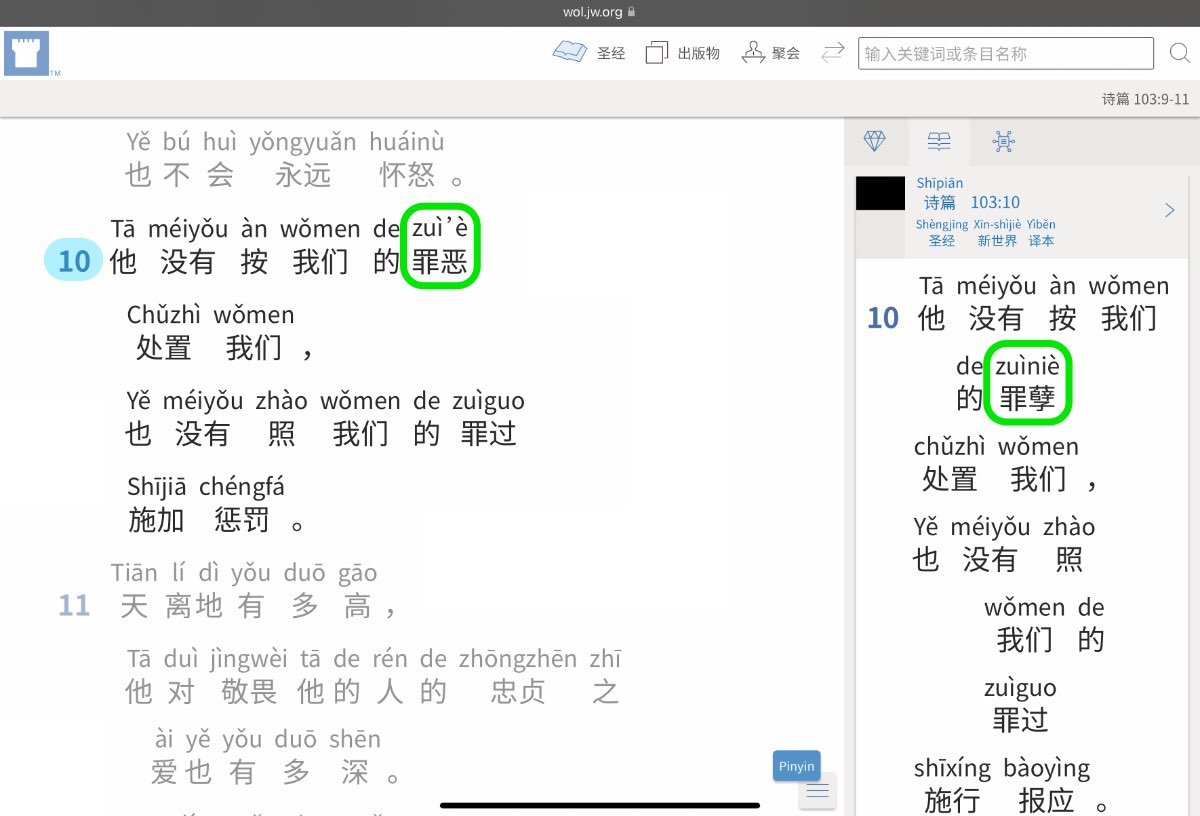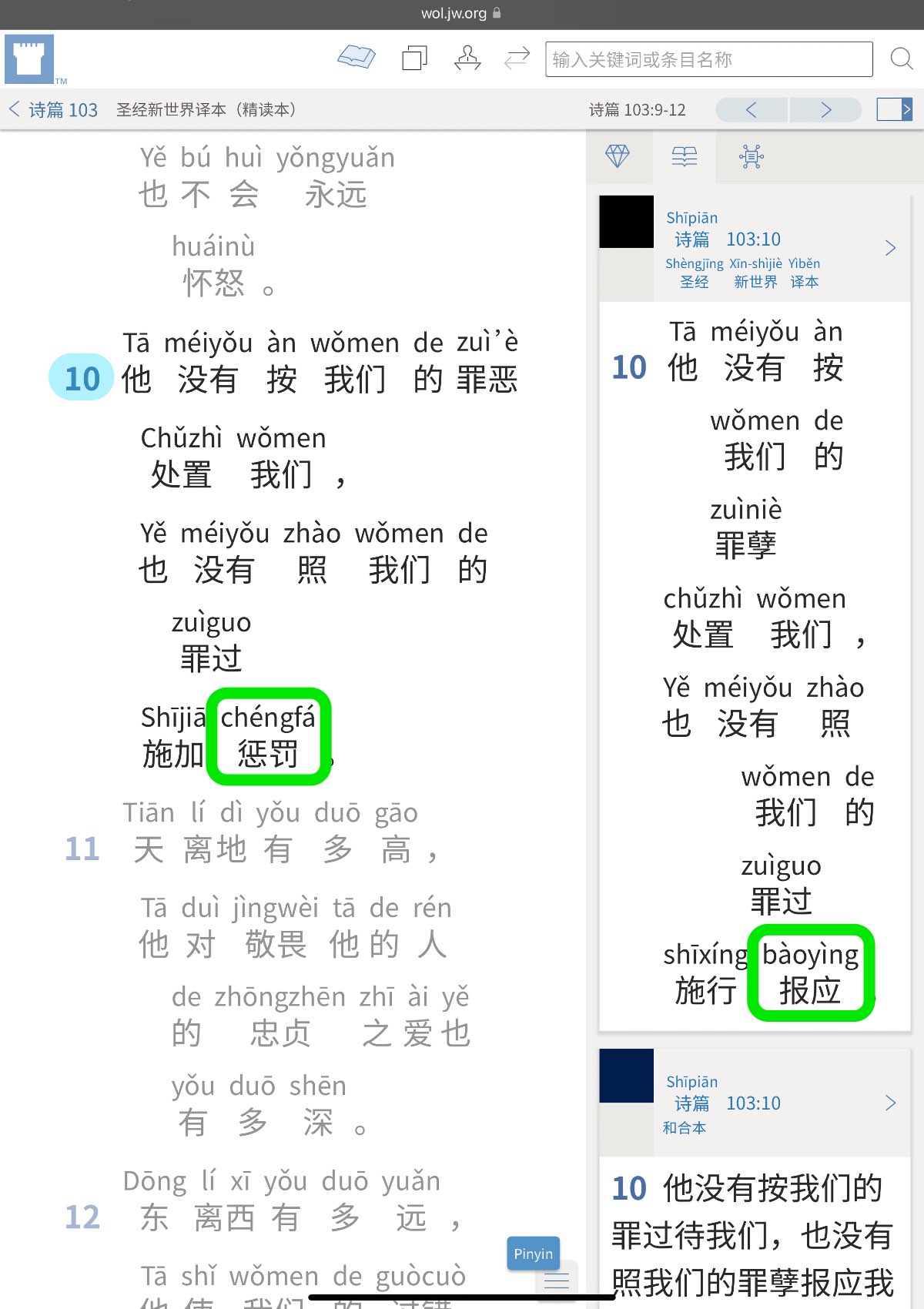yīnyì (yīn·yì sound · translating → [transcribing | transcription] 音译 音譯) ← Tap/click to show/hide the “flashcard”
Appendix A2 of the English New World Translation of the Holy Scriptures (Study Edition), entitled “Features of This Revision”, discusses vocabulary changes that have been made in the current revision, words that have been translated differently than before. As noted in various entries in the excellent resource Referenced Theo. Expressions (RTE), Appendix A2 of the current Mandarin version of the New World Translation Bible (nwtsty) correspondingly discusses words that have been translated differently in the current revision of the Mandarin NWT Bible, compared to how they had been translated before.
Since we base what we say in Jehovah’s service on his Word the Bible, the vocabulary used in it—and the way those vocabulary words are translated—should be reflected in how we speak in our ministry, at our meetings, etc. So, it is beneficial for us Mandarin field language learners to be familiar with the latest thinking from the organization on how Bible terms should be translated into Mandarin.
Units of Measurement
Appendix A2 of the current Mandarin version of the New World Translation Bible (nwtsty) points out that in previous editions of the Mandarin New World Translation, basically metric system units of measurement were used, although sometimes units from the original language were used. However, the whole number metric measurements that were considered best to use in the main text generally ended up being inexact conversions from the original measurements. Also, some metric units of measurement are named differently in different places. For example, some places use “mǐ (metre 米)” to mean “metre”, while other places use “gōngchǐ (gōng·chǐ {collective → [metric]} · {Chinese foot (⅓ of a metre)} → [metre] 公尺)”. So, the current version of the Mandarin NWT in most scriptures uses the original language units of measurement through what in Mandarin is called “yīnyì (yīn·yì sound · translating → [transcribing | transcription] 音译 音譯)”, and in footnotes it provides the metric equivalents and perhaps other information.
What does “yīnyì (yīn·yì sound · translating → [transcribing | transcription] 音译 音譯)” involve? Some Chinese-English dictionaries say that this word is used to mean either “transliterate”/“transliteration” or “transcribe”/“transcription”. What’s the difference? Is there a difference?
[Note on terminology: “Writing system” and “script” are synonymous, while an “orthography” is a “set of conventions [connected to a writing system/script] for writing a language, including norms of spelling, capitalization, emphasis, hyphenation, punctuation, and word breaks”.]
Transliteration?
The Wikipedia page on transliteration provides the following summaries to help define transliteration:
Transliteration is a type of conversion of a text from one script to another that involves swapping letters (thus trans- + liter-) in predictable ways
Transliteration is not primarily concerned with representing the sounds of the original but rather with representing the characters, ideally accurately and unambiguously.
Systematic transliteration is a mapping from one system of writing into another, typically grapheme to grapheme [e.g., letter to letter]. Most transliteration systems are one-to-one, so a reader who knows the system can reconstruct the original spelling.
Echoing the above quote, the academic paper “Two Steps Toward Digraphia in China” (Sino-Platonic Paper Number 134), by Xieyan Hincha, provides this rigorous definition of transliteration:
By transliteration is meant the letter-by-letter conversion of a text written in an alphabet into another alphabetical script, if necessary using diacritical marks, in such a way that the text can be correctly converted back into the original text by means of a transliteration table.
Transcription?
Now, compare the above to summaries provided by the Wikipedia page on transcription that help to define transcription:
Transcription in the linguistic sense is the systematic representation of spoken language in written form.
There are two main types of linguistic transcription. Phonetic transcription focuses on phonetic and phonological properties of spoken language. Systems for phonetic transcription thus furnish rules for mapping individual sounds or phones to written symbols. Systems for orthographic transcription, by contrast, consist of rules for mapping spoken words onto written forms as prescribed by the orthography of a given language. Phonetic transcription operates with specially defined character sets, usually the International Phonetic Alphabet. [emphasis added]
The above-mentioned academic paper “Two Steps Toward Digraphia in China” also provides a rigorous definition for transcription, which seems to specifically refer to phonetic transcription, as referred to in the Wikipedia quote above:
It is time to ask what exactly is a transcription system. It is a graphic system whose elements unambiguously represent the sounds of a spoken language. The transcription can be narrow or broad: in both cases one graphic symbol represents in principle precisely one single sound.
“There is Too Much…Let Me Sum Up”
To sum up, basically transliteration refers to mapping from one writing system to another writing system, while transcription refers to mapping from a language’s sounds to a graphic system like the IPA (phonetic transcription), or to a writing system with an orthography (orthographic transcription).
Thus, I would say that it’s not really appropriate to use “yīnyì (yīn·yì sound · translating → [transcribing | transcription] 音译 音譯)”—which literally means “sound translating”—to mean “transliterate” or “transliteration”. From the literal meanings of its morphemes, “yīnyì (yīn·yì sound · translating → [transcribing | transcription] 音译 音譯)” is a much better fit for meaning “transcribe” or “transcription”, which refer to mapping the sounds of a language to a graphic system or a writing system.
Going back to Appendix A2 of the current Mandarin version of the NWT Bible, when it says that this version in most scriptures yīnyì (yīn·yì sound · translates → [transcribes] 音译 音譯) (transcribes) the original language’s units of measurement, that means that it uses Chinese characters/Pīnyīn (Pīn·yīn {Piecing Together} · Sounds → [Pinyin] 拼音) to represent (as well as they can) how these units of measurement sounded in the original language. For example, the original language unit of measurement translated into English as “seah measure” is translated into Mandarin as “xìyà ({seah (measure)} 细亚 細亞)”.—2 Kings 7:1 (English/Mandarin).
Transliteration, Transcription, and Pīnyīn (Pīn·yīn {Piecing Together} · Sounds → [Pinyin] 拼音)
Besides offering definitions of transliteration and transcription, the academic paper “Two Steps Toward Digraphia in China” mentioned above also discusses whether these terms apply to Pīnyīn (Pīn·yīn {Piecing Together} · Sounds → [Pinyin] 拼音). Here are a couple of quotes:
In the case of Chinese characters, ISO has established that a transliteration between Chinese characters and Pīnyīn (Pīn·yīn {Piecing Together} · Sounds → [Pinyin] 拼音) is impossible: the supposedly more than 40,000 (“ideo-phonographic”) characters cannot be represented by the 26 letters of the Latin alphabet. There is no doubt about that. This clearly shows that Hànyǔ (Hàn·yǔ {Han (Chinese)} · Language → [(Modern Standard) Mandarin] 汉语 漢語) Pīnyīn (Pīn·yīn {Piecing Together} · Sounds → [Pinyin] 拼音) Fāng’àn (Fāng’·àn {Direction → [Method]} · {Long, Narrow Table or Desk → [Plan]} 方案) is not a transliteration system, because it does not fulfill all the criteria of a transliteration system.
If Hànyǔ (Hàn·yǔ {Han (Chinese)} · Language → [(Modern Standard) Mandarin] 汉语 漢語) Pīnyīn (Pīn·yīn {Piecing Together} · Sounds → [Pinyin] 拼音) Fāng’àn (Fāng’·àn {Direction → [Method]} · {Long, Narrow Table or Desk → [Plan]} 方案) were a transcription system, this table would contain three state-prescribed violations of the transcription principle, namely: y+i, y+in, and y+ing. In all three of these cases, two letters represent one sound. The same is true when writing y+u and w+u. This rule does not concern phonetic transcription; rather, it is an orthographic rule: in these cases <y> and <w> are artificial and arbitrary initial symbols. But phonetically these are not consonants. Consequently, in this respect Hànyǔ (Hàn·yǔ {Han (Chinese)} · Language → [(Modern Standard) Mandarin] 汉语 漢語) Pīnyīn (Pīn·yīn {Piecing Together} · Sounds → [Pinyin] 拼音) Fāng’àn (Fāng’·àn {Direction → [Method]} · {Long, Narrow Table or Desk → [Plan]} 方案) is not a transcription system.
The above quote explains that Pīnyīn (Pīn·yīn {Piecing Together} · Sounds → [Pinyin] 拼音) does not qualify as a phonetic transcription system. However, it shows that Pīnyīn (Pīn·yīn {Piecing Together} · Sounds → [Pinyin] 拼音) has orthographic rules connected to it, meaning it could be used for orthographic transcription…
No, Could It Be?
So, this academic paper concludes that Pīnyīn (Pīn·yīn {Piecing Together} · Sounds → [Pinyin] 拼音) is not a system for transliterating Chinese characters, nor is it a system for phonetically transcribing Mandarin speech. What is it, then? The paper comes to this conclusion:
As is well known, the Chinese leadership refuses to recognize Hànyǔ (Hàn·yǔ {Han (Chinese)} · Language → [(Modern Standard) Mandarin] 汉语 漢語) Pīnyīn (Pīn·yīn {Piecing Together} · Sounds → [Pinyin] 拼音) as a script and to permit digraphia [the state of having two standard scripts, Chinese characters and Pīnyīn (Pīn·yīn {Piecing Together} · Sounds → [Pinyin] 拼音)]. But scientific facts demonstrate that Hànyǔ (Hàn·yǔ {Han (Chinese)} · Language → [(Modern Standard) Mandarin] 汉语 漢語) Pīnyīn (Pīn·yīn {Piecing Together} · Sounds → [Pinyin] 拼音) Fāng’àn (Fāng’·àn {Direction → [Method]} · {Long, Narrow Table or Desk → [Plan]} 方案), including its orthography, is a writing system for Chinese. [emphasis added]

